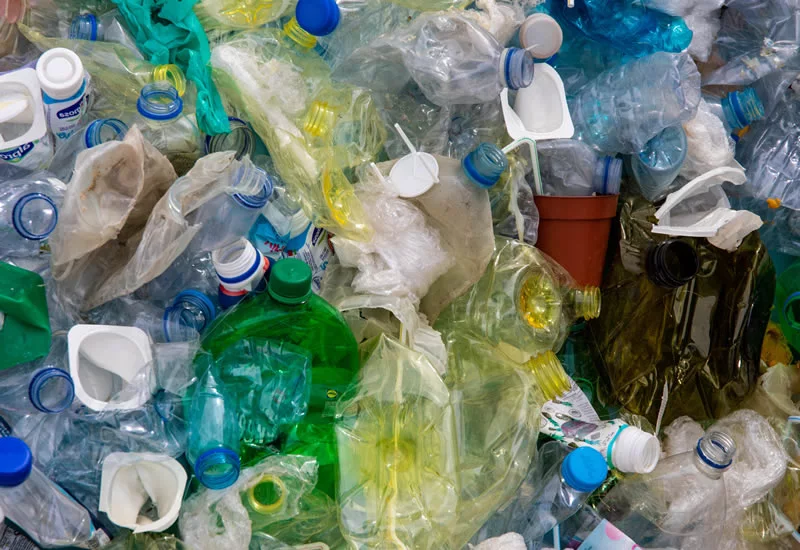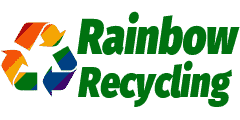Plastic waste has always been a huge problem as it has not only led to environmental pollution but also health crises too. Therefore it is crucial to know the kinds of plastic that exist and the reasons why we have to pay more attention to our home recycling bin. So, the main question is: What plastics cannot be recycled?
Thermoset plastics contain polymers that form irreversible chemical bonds and cannot be remade using the same process of manufacture. Initially, plastic is created from organic raw materials such as petroleum, wood, and coal fossils, while thermoset plastics use man-made raw materials. Well-known non-recyclable plastics include cling film, blister packaging, plastic-coated wrapping paper, composite plastic, bioplastics, and polycarbonate.
Thermoset plastics contain polymers that form irreversible chemical bonds and cannot be recycled. This article will give you more information on curbside recycling programs as well as information about types of plastic that aren’t recyclable.
- What plastics cannot be recycled and why?
- What number plastics cannot be recycled?
- Why can't all plastic be recycled by the waste management industry?
- Which plastic can be recycled?
- What to do with plastics that cannot be recycled?
- Recycling numbers 1-7 chart
- Facts about recycling plastic
- Why can't plastic bags be recycled?
- Conclusion
What plastics cannot be recycled and why?

Do you have questions regarding the recycling of plastics or what is recyclable?
You are not alone. The truth is, when it comes to plastic recycling, there are a lot of miscommunications.
This is because the process of recycling plastics is extremely complex, and many factors go into determining if plastic can be recycled or not.
Thermoset plastics are typically produced from a blend of petrochemical resins that, when cross-linked and cured, form bonds that cannot be broken down.
These bonds – often called ‘links’ – lock chemical chains into new configurations.
In this way, thermosetting plastics can be shaped without the need for additional materials (e.g., reinforcements or fillers) to strengthen them in use.
Thermoset plastic types include epoxy, phenolic, unsaturated polyester, and urethane.
The advantage of these plastics is the ability to create strong materials – often with high heat resistance and mechanical strength which might not be possible using thermoplastics. Their main disadvantage is they can’t be recycled or reused.
Thermoset plastics are also known as thermosetting plastic because they “cure” at higher than room temperatures and then harden when they cool down.
There are different manufacturing processes for thermoset plastics, but all of them involve chemical reactions between the monomers to which other chemicals are added, usually by using heated equipment like ovens or autoclaves, to create a long-chain polymer known as a polymerization reaction.
What number plastics cannot be recycled?
Have you ever noticed numbers engraved on plastic? These numbers, inside triangles made of small arrows, represent different types of plastics and each type has its characteristic, so let’s find out more about it.
1. PET (Polyethylene terephthalate)
PET is one of the most commonly manufactured plastics in the world.
PET is easy to mold and extrude, so it’s used to make soda bottles, cooking oil containers, and peanut butter jars, among other common items.
Recycling possibilities: YES
2. HDPE (High-density polyethylene)
HDPE plastics are extremely common for dishware, storage containers, shampoo bottles, detergent bottles, and toys.
It is strong and resistant to many chemicals, making it safe for food products and easy to clean. Due to their low melting point, they’re relatively easy to recycle.
Recycling possibilities: YES
3. PVC (Polyvinyl chloride)
Polyvinyl Chloride (PVC) is a soft, flexible plastic, so it’s used for a huge array of household products. Tubing, kids’ toys, trays, and furniture are often made out of PVC, which was introduced in the 1930s.
Recycling possibilities: NO
4. LDPE (Low-density polyethylene)
Low-density polyethylene is a thermoplastic polymer that’s very useful in the plastics industry. It’s often used for plastic bags, trash can liners, and grocery store bags.
It has a lower density than other plastics like high-density polyethylene or polystyrene, making it lighter to not weigh people down when they carry their purchases.
Recycling possibilities: POSSIBLE
5. PP (Polypropylene)
Polypropylene, a plastic polymer, is used to make products ranging from food containers to clothing. It is also used in construction materials like those used to create bottles, ropes, and carpets.
It’s also used to produce recyclable thermoformed packaging that protects your food as well as liquid detergent bottles.
Recycling possibilities: POSSIBLE
6. PS (Polystyrene)
Polystyrene is one of the most versatile plastics available, with multiple uses that make it a perfect choice for all types of disposable products.
Its main product is recycled bin Styrofoam, so it’s commonly used for plastic cups, food packaging, etc.
Recycling possibilities: POSSIBLE
7. Other
Any other type of plastic that can’t fit in the previous 6 categories belongs to category no. 7. These are usually a mix of different types of plastics.
Recycling possibilities: POSSIBLE
Why can’t all plastic be recycled by the waste management industry?
Even though they all look the same, different kinds of plastic can’t be mixed because each kind needs to be handled differently.
Different types of plastic have different numbers on the bottom, so proper waste management is the key.
Each number stands for a different kind of chemical called resin, which is used to make that type of plastic.
Each resin melts at a certain temperature, so when it’s recycled into a new item, it needs to be melted down at the right temperature or it won’t become useful.
Factories that melt down plastics and make them into new things are set up only to take specific kinds of resin.
What’s the deal with that number on the bottom? Each number stands for a different type of plastic polymer resin.
When those numbers are separated, it tells factories what resins are there so they can match them to the right melting temperatures. So yeah, the number is SUPER important!
Which plastic can be recycled?

We’ve all had plastic bottles, and we probably all have at least one plastic bag in our drawer.
I think even the most environmentally aware among us just can’t resist a plastic bag when it’s time to go grocery shopping.
It’s hard to avoid plastic altogether—and there’s no way to avoid it without changing our habits altogether!
As long as there’s a demand for it, there will be a supply. We need to take advantage of the materials available to us that are recyclable, and we need to learn how to recycle as much as possible!
There are so many benefits to recycling! Plastic, in particular, is beneficial because it extends the lifetime of non-renewable resources like petroleum, and can be a cost-saving measure.
It doesn’t cost very much to recycle plastic, but the benefits add up quickly.
Anything you can do to lower your use of virgin materials or extend their lifetime helps the environment.
If you’re trying to become more environmentally friendly, a plastic recycling bin is a great place to start!
If you’re looking to recycle your plastics, you’ll want to be sure to separate them into their categories. You can tell what type of plastic something is by checking the number on the bottom.
So, below you can find some examples of which plastics can be recycled, separated by numbers.
Types that ALWAYS can be recycled:
- 1 – Polyethylene Terephthalate (PET) – soda and water bottles, mouthwash bottles, peanut butter containers, salad dressing, and vegetable oil containers.
- 2 – High-Density Polyethylene (HDPE) – shampoo bottles, toys. chemical containers, pipe system.
- 5 – Polypropylene (PP) – plastic containers, reusable water bottles, medical components, outdoor furniture, toys, luggage, car parts, margarine tubs.
Types that SOMETIMES can be recycled:
- 3 – Polyvinyl Chloride (PVC) – PVC window frames, meat/deli wrap, shrink wrap, flexible packaging, blood bags, resilient flooring, vinyl paneling, phonograph records, carpet backing, traffic cones, garden hoses.
- 4 – Low-Density Polyethylene (LDPE) – plastic wraps with pressurized air inside; coatings for paper milk cartons and hot & cold beverage cups; some squeezable bottles (honey, mustard), food storage containers, container lids.
- 6 – Polystyrene (PS) – disposable cutlery, plastic models, CD’s & DVD cases, and smoke detector housings.
- 7 – Others – car parts, baby bottles, eyeglasses, plastic CDs, or exterior lighting fixtures.
What to do with plastics that cannot be recycled?
So, you know that certain plastics are not recyclable without being melted down and re-injected into a mold to be turned into a new product.
And yet, you still have the question: What do I do with the plastic that may not be recyclable?
First, shoot your shot with your local recycling center. You never know: They might have the technological capability to recycle any plastic code. That would solve a lot!
Second, if you want to cut down on your plastic use in general, consider changing up some of your habits and behavior.
For instance, avoiding single-use products and items—like plastic water bottles and utensils—is a great way to start!
Third, consider ways you can reuse items you’d otherwise throw away or recycle. You can often use items in new ways around the house!
Recycling numbers 1-7 chart
To make it easier for you to sort your plastics, I’ve provided this recycling chart. I know that sorting your plastics can be a hassle, but we’re here to help. You can print out this chart and consult it whenever you need a little extra help.
| NUMBER | USED IN | STATUS | RECYCLING FOR |
| ♳ PET | Soft drinks, water, and soda bottles; food packages | Hard to clean; absorbs bacteria | Carpet, clothes, furniture, toys |
| ♴ HDPE | Pipe system; shampoo bottles; chemical containers | Safe for food storage; no chemicals transmission | Fences, detergent bottles, pens, floors |
| ♵ PVC | Clear food packaging; oil bottles; mouthwash bottles | Not recommended for a long-term food storage | Cables, paneling, hoses, road cones |
| ♶ LDPE | Shopping bags; clothing; carpets; | Doesn’t transmit chemicals into food | Envelopes, lumber, trash-can liners |
| ♷ PP | Food bottles; medicine bottles; straws | Doesn’t transmit chemicals into food | Brooms, cables, ice scrapers |
| ♸ PS | Disposable cups; take-out containers; egg cartons | Possibly carcinogen; not recommended for food storage | Foam packaging, insulation |
| ♹ OTHER | Water jugs; nylon; some food containers | Contains Bisphenol A, connected to heart disease and obesity | Custom-made products |
Facts about recycling plastic
Plastics are among the most versatile and commonly used materials in the world, and whilst no one can deny the profound impact they have had on the last 100 years of human history, our reliance on the various forms of plastic has made developing an efficient method of plastic recycling essential.
To give you a better overview of what plastic means to our planet, here are 15 facts about plastic that’ll blow your mind:
- The US alone produces 34 million tons of plastic waste a year—that’s almost as much as the weight of the entire population of Canada!
- Plastic production has increased by 200 times in the last 50 years.
- Only 9% of plastic waste gets into the recycling process.
- The average person consumes 70,000 microplastics each year by drinking water and breathing air contaminated by them.
- Plastic bags are used for an average of 12 minutes before being thrown away or recycled.
- Recycling plastic bags costs more than making new ones it costs seven times as much! And we need to do it because they take 1,000 years to decompose in landfills.
- Plastic bottles take 450 years to decompose in landfills–and they break into dangerous microplastic atoms during that time!
- There is enough plastic on earth to fill 822 Empire State Buildings!
- Plastic was first used in 1862 to make doll heads.
- In 2016, the world produced 348 million metric tons of plastic (that’s equal to the weight of 1 billion elephants).
- 4 – 5 trillion plastic bags are produced worldwide every year (that’s equal to over 850 bags for every adult on Earth).
- The average American throws away 309 pounds of plastic a year (according to Greenpeace).
- More than half (60%) of all seabirds have eaten plastic at some point in their lives.
- There are approximately 100 million tons of plastic floating around in the ocean right now.
- The plastics branch is the third-largest manufacturing industry in the world, employing 2.5 million people and generating over 300 billion US dollars every year.
Why can’t plastic bags be recycled?
If you’re wondering what you can do with all those plastic bags, wraps, and films you’re collecting at home, and why recycling can’t accept plastic bags, here’s the fact: they are technically recyclable!
However, recycling plastic bags (garbage, shopping, zip-lock, bread, wood pellet, etc.) and plastic film (shrink wrap, packing pillows, plastic bubble wrap, flexible plastic food packaging, etc.) are a major problem for single-stream recycling.
This means that to recycle them, you have to take them somewhere special that has the equipment needed to deal with them.
It’s a bummer that such useful items can’t be recycled properly; however, we encourage you to be creative with how you use them before disposing of them. Such as:
- If you have any bread bags or zip-lock bags that are still in decent shape, you can use them for storing frozen foods or organizing small items around the house.
- If you have any extra trash bags or shopping bags lying around that aren’t too worn out, they can be reused again and again.
- And if you’re really up for a challenge (or have kids), you can try making some fun crafts out of recyclable materials plastics like old bubble wrap and wood pellet bags!
Conclusion
It is time to change our mindset toward plastic recycling. The truth is that we have a lot of responsibility as humans on this earth.
We are responsible for the quality of resources that we have. If they get depleted, then it is our fault. That is why it is important to learn more about ways to reduce plastic consumption.
Now that you know what plastics cannot be recycled, it’s time for you to do your part. So how can you help?
Recycle as much of your plastic waste as you can, listen to what the science says, and encourage others to do the same.
If we all make a conscious effort to recycle our plastics, one step at a time, then maybe one day we can help our world to achieve a truly sustainable future.

Who wrote this? I need it for my citation for my essay, please.